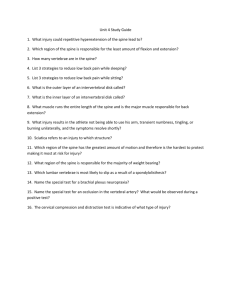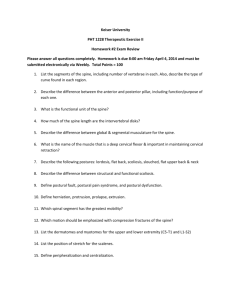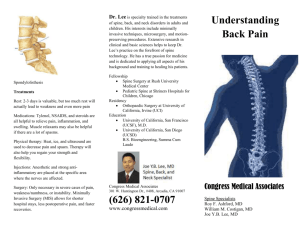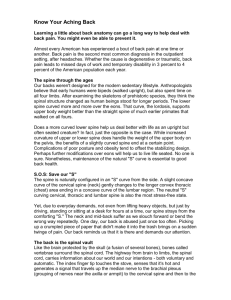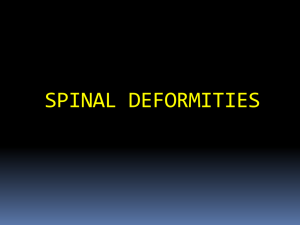File - Beau Howell Portfolio CSS43
advertisement
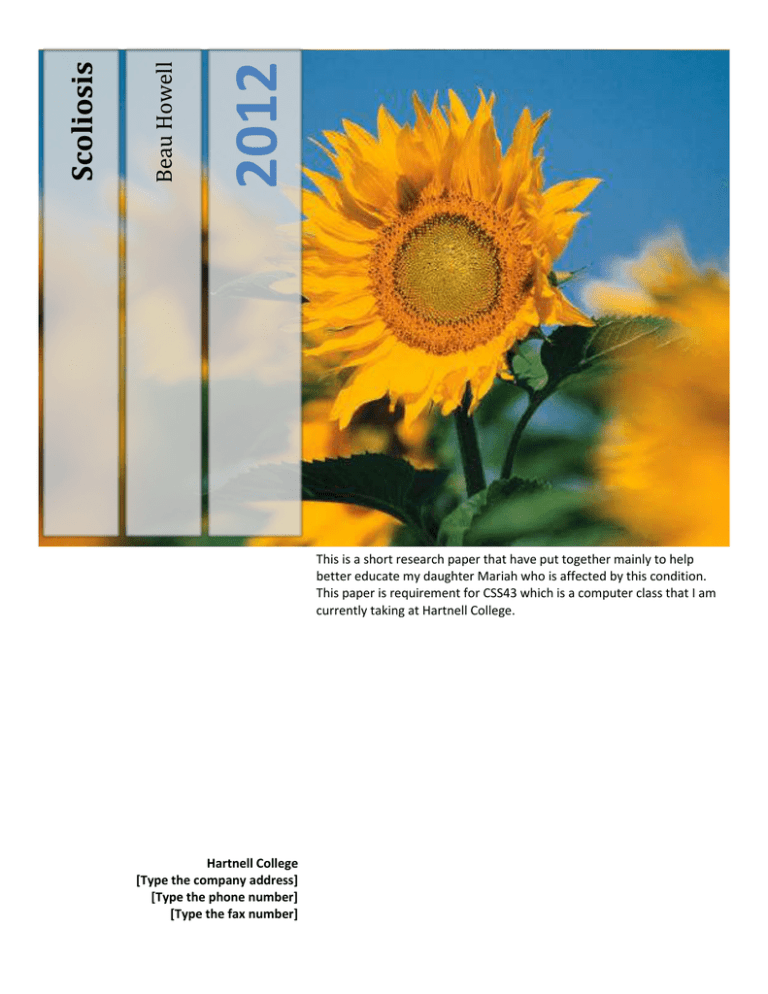
2012 Scoliosis Beau Howell This is a short research paper that have put together mainly to help better educate my daughter Mariah who is affected by this condition. This paper is requirement for CSS43 which is a computer class that I am currently taking at Hartnell College. Hartnell College [Type the company address] [Type the phone number] [Type the fax number] Table of Contents Introduction .................................................................................................................................................. 1 Cause ............................................................................................................................................................. 1 Symptoms ..................................................................................................................................................... 2 Cures and Remedies,..................................................................................................................................... 2 Observation............................................................................................................................................... 2 Braces ........................................................................................................................................................ 2 Surgery .......................................................................................................................................................... 3 Spine Basics ................................................................................................................................................... 3 Spinal Curves ............................................................................................................................................. 3 Spinal Cord and Nerves ............................................................................................................................. 5 Muscles and Ligaments ............................................................................................................................. 5 Intervertebral Disks................................................................................................................................... 5 Nucleus pulposus. ..................................................................................................................................... 6 Annulus fibrosus. ...................................................................................................................................... 6 Facet Joints................................................................................................................................................ 6 Introduction I have decided to my research paper on Scoliosis due to the fact that my thirteen year old daughter is affected by this condition. I plan to do the necessary research to better educate myself so I can better understand exactly what is the cause and effect of this condition so my daughter can better informed of the situation at hand. Also I will be posting all of my research and findings to my personal website so that anyone who is interested in this topic can easily check out my findings and follow all links that I think are important. Cause Scoliosis is not a disease—it is a descriptive term. All spines have curves. Some curvature in the neck, upper trunk and lower trunk is normal. Humans need these spinal curves to help the upper body maintain proper balance and alignment over the pelvis. However, when there are abnormal side-to-side (lateral) curves in the spinal column, we refer to this as scoliosis. http://www.iscoliosis.com/causes.html Scoliosis causes a sideways curve of your backbone, or spine. These curves are often S- or Cshaped. Scoliosis is most common in late childhood and the early teens, when children grow fast. Girls are more likely to have it than boys. It can run in families. Symptoms include leaning to one side and having uneven shoulders and hips. Sometimes the curve is temporary. It might be due to muscle spasms, inflammation or having different leg lengths. A birth defect, tumor or another disease might cause the spine to have a curve that isn't temporary. People with mild scoliosis might only need checkups to see if the curve is getting worse. Others might need to wear a brace or have surgery. NIH: National Institute of Arthritis and Musculoskeletal and Skin Diseases Symptoms Shoulders are different heights—one shoulder blade is more prominent than the other Head is not centered directly above the pelvis Appearance of a raised, prominent hip Rib cages are at different heights Uneven waist Changes in look or texture of skin overlying the spine (dimples, hairy patches, color changes) Leaning of entire body to one side http://www.iscoliosis.com/symptoms.html Cures and Remedies, Observation According to the Mayo Clinic, most mild cases of scoliosis probably don't need treatment with a brace or surgery, but should be observed at scheduled check-ups by a doctor. A doctor may request an examination of the spine every four to six months to see if any changes occur to the spine, as in a worsening of the curvature, explains the National Institute of Arthritis and Musculoskeletal and Skin Diseases. If a child's bones have reached maturity or stopped growing, the risk of curve progression remains low, but in children whose bones continue to grow, they may develop a worsening curvature of the spine. If this is the case, the doctor may recommend additional treatment. Braces A doctor may advise wearing a brace to stop the progression of a curve in the spine, reports the National Institute of Arthritis and Musculoskeletal and Skin Diseases. A doctor recommends a brace in a moderate case of scoliosis, especially while the bones continue to grow. The braces need be worn throughout the day and evening, because the efficacy rate of a brace coincides with the number of hours worn. In other words, an increased number of hours in wearing the brace, results in less deterioration of the condition. However, the Mayo Clinic explains that wearing a brace won't cure scoliosis, or reverse the curve, but it usually prevents further progression of the curve. Surgery A doctor might suggest scoliosis surgery for a severe case of scoliosis, or if the braces fail in preventing further progression of the curve. Surgery reduces the severity of the spinal curve and prevents it from getting worse. According to Medline Plus, the surgery involves correcting the curve, though not all the way, and fusing the bones in the curve together. The doctor may also put in a metal rod or other devices called implants. The implants stay in the body and help keep the spine straight following surgery. Read more: http://www.livestrong.com/article/130819-remedies-scoliosis/#ixzz1p7lM7vuH Spine Basics Understanding your spine and how it works can help you better understand some of the problems that occur from aging or injury. Many demands are placed on your spine. It holds up your head, shoulders, and upper body. It gives you support to stand up straight, and gives you flexibility to bend and twist. It also protects your spinal cord. Spinal Curves Your spine is made up of three segments. When viewed from the side, these segments form three natural curves. The "c-shaped" curves of the neck (cervical spine) and lower back (lumbar spine) are called lordosis. The "reverse c-shaped" curve of the chest (thoracic spine) is called kyphosis. These curves are important to balance and they help us to stand upright. If any one of the curves becomes too large or small, it becomes difficult to stand up straight and our posture appears abnormal. Abnormal curvatures of the spine are also referred to as spinal deformity. These types of conditions include kyphosis of the thoracic spine ("hunchback") and lordosis of the lumbar spine ("swayback"). Scoliosis is another type of spinal deformity. When viewing the spine from the front or back, scoliosis is a sideways curvature that makes the spine look more like an "S" or a "C" than a straight "I." Your spine is made up of small bones, called vertebrae, which are stacked on top of one another and create the natural curves of your back. Vertebrae These bones connect to create a canal that protects the spinal cord. The spine from the back. The spine from the front. Parts of the lumbar spine. The cervical spine is made up of seven small vertebrae that begin at the base of the skull and end at the upper chest. The thoracic spine is made up of 12 vertebrae that start from the upper chest to the middle back and connect to the rib cage. The lumbar vertebra consists of five larger vertebrae. These vertebrae are larger because they carry more of your body's weight. Spinal Cord and Nerves The spinal cord extends from the skull to your lower back and travels through the middle part of each stacked vertebra, called the central canal. Nerves branch out from the spinal cord through openings in the vertebrae and carry messages between the brain and muscles. The cauda equina. The spinal cord ends around the first and second lumbar vertebrae in the lower back and continues as nerve roots. This bundle of nerve roots is called the cauda equina. They exit the spinal canal through openings in the vertebrae (foramen), just like other nerve roots. Muscles and Ligaments These provide support and stability for your spine and upper body. Strong ligaments connect your vertebrae and help keep the spinal column in position. Healthy intervertebral disk (cross-section view). Intervertebral Disks Intervertebral disks sit in between the vertebrae. They are flat and round, and about a half inch thick. Intervertebral disks are made up of two components. Nucleus pulposus. The nucleus pulposus is jelly-like and makes up the center of the disk. The jelly is partly made of water and gives the disk flexibility and strength. Annulus fibrosus. This is the flexible outer ring of the disk. It is made up of several layers, similar to elastic bands. When you are standing or moving, weight is put onto the nucleus. In response, the nucleus expands. The annulus holds the nucleus in place. This allows movement to take place, yet maintains the strength of the spine. In effect, disks act as shock absorbers for the spine. The intervertebral disk is a very important structure. Many nerve endings supply the annulus and, as a result, an injured annulus can cause pain. Facet Joints Between the back of the vertebrae are small joints that also help your spine move. These facet joints have a cartilage surface, very much like a hip or a knee joint does. The facet joints are important for allowing rotation of the spine but may develop arthritis and become a source for low back or neck pain.
